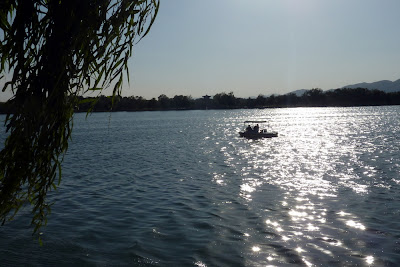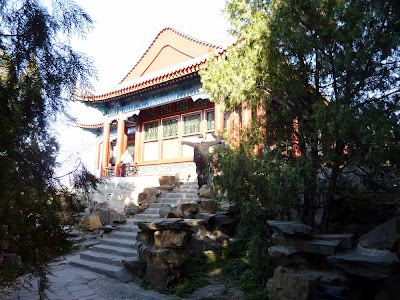After lunch we went to the Summer Palace with Andrew.
The Summer Palace is about 10 miles northwest of the center of Beijing, occupying an area of about 750 acres. Since Beijing University is also in the northwest, we were reasonably close and took the subway there. This is the largest royal park in China which was constructed in 1750 as an area for the royal family to rest and entertain, becoming a main residence for them at the end of the Qing Dynasty. In 1860 the Anglo-French Allied Forces looted it and then burned it, a fire lasting for 3 days which destroyed much but not all of it. It was rebuilt in 1888 but then destroyed again in 1900. Supposedly the most interesting Empress Dowager Cixi embezzled navy funds to reconstruct it as a personal resort.
There are over 3,000 manmade structures, occupying a total building space of about 800,000 square feet consisting of structures such as towers, bridges, corridors, and pavilions.
 |
| This is the building at the entrance to the north entrance of the Summer Palace |
 |
| Another view of Suzhou Street |
 |
| The entrance to the rest of the Summer Palace |
 |
| Most or all of the Summer Palace was destroyed during the opium wars in the late 1800s. Most of it has been recently restored, but this area is being left unrestored to remember the event. |
 |
| In the background is the stone boat, financed by Cixi with funds embezzled from the navy. |
 |
| Another view of the stone boat. |
 |
| There were a lot of people lined up to take a ride on the dragon boat, mostly tourists. |
 |
| The Long Corridor, built in the middle of the 18th century, it is about 2500 feet long and has more than 14,000 paintings. |
 |
| Looking up on the Long Corridor roof |
 |
| We took a boat ride farther back--no dragon and no long lines; mainly local people. Much better choice. |
 |
| Kunming Lake is a man made lade covering an area of over 500 acres; the excated area was used to make Longevity Hill , about 200 feet high. |
 |
| The view across the lake--I think this place belonged to some of the leaders. |
 |
| Another view across the lake |
 |
| And yet another |
 |
| This is the island area. |
 |
| The 17 arch bridge is in the background |
 |
| 17 arch bridge |
 |
| Life size bronze ox said to have power to control floods. |
 |
| Bronze Qilin: fire dragon said to arrive or depart with a sage or illustrious ruler. |
 |
| These two animals (bird here and dragon in following picture) were in front of the Hall of Benevolence where Empress Cixi, a concubine who unofficially but very effectively took over the government from 1847 to 1908, handled court officials and received foreign diplomats. It had electricity and one of the first phone in Beijing. |
 |
| Picture of Empress Cixi |
 |
| After we left the summer palace we were invited to Andrew's apartment where we met his wife, Jessie, and his son , Howard. |
 |
| Jessie had made dumplings for us--delicious, my favorite Chinese meal. |























































No comments:
Post a Comment